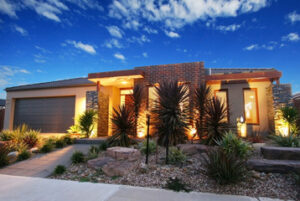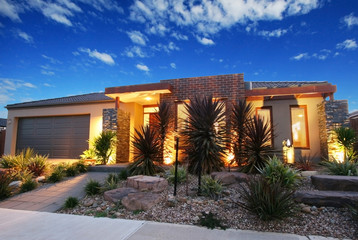Landscape lighting transforms your home’s exterior into a captivating wonderland after dark. It highlights the most beautiful architectural features and natural elements on your property while ensuring safety by providing ample illumination for walkways and entryways.
Brass is a popular material for fixtures and bulbs because it develops a beautiful patina over time, adding a sophisticated, classic look. Copper is another high-end choice that offers a rustic, natural appeal. Click Here to learn more.
Lighting is a powerful way to bring a property’s unique features to light and enhance its beauty during the night. However, not all outdoor lighting is created equal, as certain options are designed to be more energy-efficient than others. LED landscape lighting offers significant cost-savings and long life, reducing overall energy consumption and making for an eco-friendly choice.
Additionally, utilizing fixtures that direct light downward and limit upward glare will help reduce the amount of light pollution in your neighborhood. Finally, implementing timers or other smart technology will ensure that your lights only turn on when needed, further optimizing energy efficiency and creating a more sustainable outdoor space.
Choosing the right bulbs is another crucial factor in creating a sustainable landscape lighting plan. Quality outdoor lighting bulbs are made to withstand environmental challenges like heat, moisture, and temperature extremes. Top brands also feature bulbs that are specifically designed to be more energy-efficient, reducing costs in the long run.
A skilled contractor will be able to guide you through the various fixture options that are available, as each one has its own set of benefits and drawbacks. For example, brass and copper are popular choices for landscape lighting due to their resistance to corrosion, but they may require regular maintenance to keep them looking their best.
Other options include using stainless steel fixtures for a sleek, contemporary look that blends in well with natural surroundings and architectural features. Stainless steel is also a great choice for areas that experience frequent rainfall, as it holds up well to wet conditions.
Once the design is mapped out, it’s important to consider how your lighting will impact traffic patterns and safety. For example, placing spotlights on unique architectural features or focal points can help people navigate around your property after dark. Similarly, lighting pathways and walkways can be essential for ensuring that guests don’t become lost or injured while exploring your outdoor spaces at night.
When it comes to maintenance, regularly checking your lighting system for faulty connections or power supply issues is essential to maintaining a sustainable landscape. Signs of a problem with your lighting system can include tripped breakers or lights that are flickering. An experienced contractor can identify common problems and repair them promptly, preventing any disruptions to your outdoor lighting scheme.
Safety
If you’re planning on installing landscape lighting yourself, it is important to follow proper safety precautions. Start by turning off the power to the area where you’ll be working, and make sure all wire connections are secure. It’s also a good idea to wear gloves and eye protection during the installation process, especially when handling electrical components. In addition, always use GFCI outlets for outdoor lights to avoid shocks.
Before starting the installation, it’s important to clear the yard of any debris and vegetation that could interfere with the wiring system. Also, it’s a good idea to use stakes and twine to mark the areas where you plan on placing the lights. This will help ensure a smoother installation and prevent any mishaps down the line.
It’s essential to properly install landscape lighting for both function and visual appeal. Illuminating walkways and entranceways reduces the risk of accidents during nighttime, while highlighting unique architectural features and plants creates a stunning ambiance. Additionally, well-lit areas deter criminals by making it harder for them to hide or approach undetected.
Landscape lighting systems use low-voltage electricity, so it’s important to ensure that your yard is properly prepared before beginning the installation. This step is particularly critical for preventing fires caused by improper maintenance. For example, halogen bulbs can generate enough heat to ignite dry mulch or landscape clippings. This is a serious problem because it can result in costly repairs and insurance claims. However, by using the correct wattage and keeping the lights away from easily flammable materials, you can drastically reduce this risk.
Finally, it’s a good idea to have a qualified professional perform the installation. They’ll know the best ways to protect the wiring and ensure that it complies with local codes and regulations. Additionally, they’ll be able to recommend energy-efficient options and provide tips for maintaining your landscape lighting system.
Investing in landscape lighting is a great way to increase your home’s curb appeal, but it’s important to take some time to consider the safety measures involved. By following these simple tips, you can rest assured that your landscape lighting will be safe for both you and your family.
Visual appeal
A well-designed landscape lighting plan accentuates architectural details, highlights trees and palms, and creates a warm and inviting ambiance. It also helps deter burglars by illuminating walkways and entryways. In addition, the proper use of lighting can reduce the number of trip and fall accidents, which account for 46K deaths a year. Moreover, it can extend the use of outdoor areas after dark and allow homeowners to enjoy their gardens, patios, pools, and decks.
When designing your landscape lighting, you should consider the amount of light that is needed and how it will affect the overall look. Depending on the size of your space and the height of objects, different types of lighting fixtures will be required. You should also consider the brightness of the fixture, as this will determine how much light it emits. You should always choose bulbs that are bright enough to illuminate the space without causing any glare or shadowing. The best way to measure brightness is by using lumens, which is a measurement of the amount of visible light produced by a fixture. This is important because it enables you to create the perfect look with your landscape lighting by ensuring that the right brightness level is achieved.
By utilizing the right techniques, you can enhance your property’s visual appeal and make it stand out from the rest of the neighborhood. For example, up-lighting can make trees appear taller and more majestic, while down-lighting can highlight cozy seating areas. Moreover, silhouetting can be used to accentuate the texture and shape of objects.
A professionally designed landscape lighting plan not only adds to the aesthetics of your home but also increases its value. In fact, it can be a major selling point during the real estate market. Besides, it helps you stay connected to nature by attracting nocturnal wildlife and minimising light pollution. As a result, it will provide a tranquil environment to relax and unwind after a long day. Additionally, you can incorporate color-changing lights to match the theme of holidays and events, which will enhance your curb appeal and attract more guests.
Maintenance
Landscape lighting is an investment that enhances your property’s beauty, increases safety, and extends the enjoyment of outdoor living spaces well into the night. As with any investment, it’s important to manage it properly to get the most from your system. This includes regular inspections, cleaning, and maintenance to ensure the system functions properly and looks its best throughout the year.
During routine upkeep, you’ll be able to identify potential issues before they become problems and repair them as needed. This can help prevent costly repairs down the road.
For example, if you notice your path lights shifting out of alignment or that your uplighting for trees isn’t working as expected, you can correct the problem quickly by manually readjusting them. Regularly wipe down fixtures to remove any buildup that reduces light output. This can be done using a cloth and mild detergent, making it an easy, effective way to maintain the appearance of your landscape lighting.
It’s also important to regularly check the condition of your wiring, especially if you notice any signs of corrosion or other damage. This will help avoid potential electrical hazards and keep your system functioning efficiently. If you haven’t done so already, consider upgrading your existing wiring to a larger gauge to prevent excessive wear and tear on the connections.
Another maintenance task that should be performed regularly is replacing your bulbs. Be sure to choose high-quality LED bulbs that are compatible with your existing lighting system to maximize their lifespan. When you replace your bulbs, it’s a good idea to switch out any burnt-out ones immediately, as they can pose a fire risk if left unattended.
In addition to inspecting and replacing bulbs, it’s essential to trim any vegetation that is obstructing your landscape lighting and reducing its effectiveness. You can also trim plants that are growing too close to your lighting systems to prevent overheating or fire hazards.

